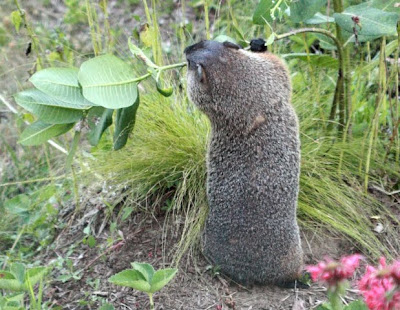 This is the second article of mine that was published in the local paper, the Franklin Country Gazette. My third article may be out in this week's paper, but I don't yet have a copy.Why Grow a Lawn?
This is the second article of mine that was published in the local paper, the Franklin Country Gazette. My third article may be out in this week's paper, but I don't yet have a copy.Why Grow a Lawn?In my childhood, I lay on the grass of my Virginia lawn, picking dandelions, four-leaf clovers, and bluets. Now it is common to see signs warning that the grass is unsafe even to walk on, placed sidewalks by companies who want to convince us that a poisonous and homogonously flower-free lawn is somehow good for our children.
Prior to the twentieth century, the typical American yard was a mix of gardens and packed dirt. The clipped lawn originated in England, where it was a status symbol displayed by those who could afford to not to devote all of their land to livestock or farming. Those green power statements were watered with England’s soggy weather, mowed with scythes, and weeded by hand.
Wealthy Americans sought to emulate the practice, but gardeners are expensive, and neither the dry North American climate nor the native grasses were suitable for lawns. It took the introduction of mass-produced human-pushed reel lawnmowers, subsidized water, and garden hoses to make lawns a possibility for the middle class. And, oddly, the USDA had a hand in solving the grass “problem”: in 1915 they teamed up with the US Golf Association (golf itself originating in Scotland, a land of open grasslands) to find grasses that could withstand the North American climate. The final nail in the lawn-conformity coffin was a pamphlet circulated by the American Garden Club which stated that lawn was to be "a plot with a single type of grass with no intruding weeds, kept mown at a height of an inch and a half, uniformly green, and neatly edged."
It takes a barrage of chemicals to emulate English landscape, and these chemicals are dangerous to us and to our environment. Canada has banned all weed-and-feed lawn products. Here in Franklin it is illegal to spread pesticide, herbicide, or lawn fertilizer closer than 50 feet to a wetland. (And yet even though so many of us live adjacent to wetland, we are still solicited by lawn-chemical companies.)
For those who simply cannot do without lawn, there are organic methods of lawn-care, such as using old-fashioned push mowers. Corn gluten can be used as a pre-emergent herbicide. Lawn that is mowed higher is more healthy, and therefore more able to out-compete weeds. Clover can be added to contribute nitrogen to the soil, and newer varieties of grass require less water or no mowing at all.
For those who don’t care to obsess over having their lawn be an unblemished shade of green, however, there is an easier option. In a recent New York Times article, author Robert Wright suggests that we continue to grow and mow our existing lawns, but leave the chemicals out, and let the weeds back in. “Next time you see a yard full of sprouting dandelions,” he writes, “note that they look remarkably like things we call ‘flowers’.” Activities that require lawn can just as easily be played in the presence of weeds.
What else can we do? To the aesthetically-minded, a yard is a canvass to be painted with flowers and foliage. To environmentalists, a yard is a place to recreate habitat. To those who like a good meal, a yard is the place to grow vegetables. Alone or in concert, all of these approaches can bring our yards back to our not-so-distant American roots and away from the idealized indusrial lawn.
For those trying to recreate habitat, a good option can be to grow a backyard meadow. Meadow needs to be mowed only once a year, needs no water, no herbicides, no pesticides, and no fertilizer. There are many flowering plants that inhabit meadows, and the local wildlife will thank you for the food and shelter that your meadow provides.
The best way to grow a meadow, from a habitat perspective, is to kill the existing grass and replace it with North American native plants. An example of such a meadow can be seen at Garden in the Woods, in North Framingham, and during the growing season, its flowers are a wonder to behold. But a lawn left to grow tall can still be an environmental improvement. At Idylbrook Field, in Medway, mowed paths meander through a heady mix of native and non-native plants.
I am experimenting with such a meadow in my own yard. In theory, it will be kept tidy by maintaining a mowed strip around the edge. Last Autumn I sprinkled the area with the seeds of native meadow flowers and grasses. Already I can see milkweed growing. And I have an emergency backup: if the meadow doesn’t turn out to my satisfaction, I can mow it down and call it a weedy lawn once again.





























































